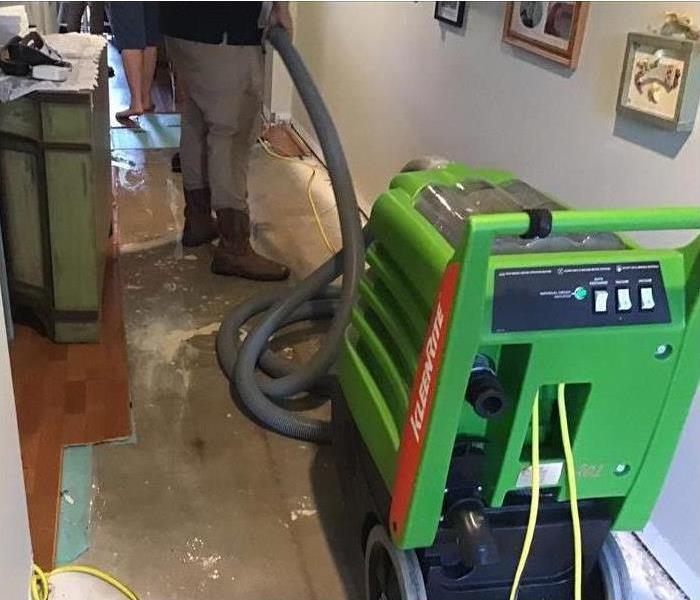How To Repair Laminate Flooring Water Damage
12/9/2022 (Permalink)
How to Fix Water Damaged Laminate Flooring
If you’re reading this, it’s likely because you have some water damage to your laminate flooring. It doesn’t matter whether that damage is new or old; we're going to give you all the information you need to get started with repairing your laminate floors.
Preparing the flooring.
To prepare the flooring, first remove any loose debris and wipe the laminate with a damp cloth.
Next, set up fans if you are drying the flooring in a room. Fans will help dry out your laminate more quickly than other methods, which can help prevent permanent damage from occurring due to prolonged exposure to moisture over time (which would cause mold). If there is no way for natural air flow into or out of this area due to walls being built around it, then consider placing an air conditioner under or near where it sits so that hot/cold air won’t mix, creating condensation on both sides of where they meet at each end point.
Assessing the damage.
First off, is your flooring damaged in one area or many? If it’s only one small section of your flooring, chances are that won't be too much of a problem and may just require a bit more time on your part. However, if there are multiple areas of laminate water damage throughout your home or office space then repairing those areas all at once can be quite overwhelming (not to mention costly).
Second: how deep into the wood did the water get? The deeper into the wood it gets, the harder it will be for you to fix this issue yourself without having some professional help. This could mean hiring someone or at least making sure they know what they are doing before starting any repairs yourself! You don't want them ruining an entire room worth of laminate flooring because they didn't know how far out into each plank they should go while working on fixing whatever caused this mess in first place.
Repairing water damage to laminate flooring.
When water damage occurs in laminate flooring, it is important to act quickly to prevent further damage. The moisture from the water will enter the core of the laminate flooring and cause it to warp, cup, become brittle and crack. If you do not fix this type of damage immediately, then it will get worse over time.
When repairing your wet laminate flooring, you have two options: use an electric heat gun or hair dryer on high heat. With either one of these tools, hold them over the damaged area until they are completely dry (this may take several minutes). Once they are dry, they should be fine again.
Cleaning the flooring and removing any mildew or mold.
Cleaning the flooring and removing any mildew or mold:
- Use a vacuum to remove any dirt or debris that has settled on your laminate flooring.
- Buy a mildew remover from your local hardware store or use a solution of 50% water and 50% vinegar (we recommend making enough for both sides of your laminate if you're working with two-sided flooring). Apply this mixture directly onto the area where there is mildew, let set for 10 minutes, then rinse it off with warm water until all traces are gone.
- If you find any mold growing on your laminate, scrub it off using bleach diluted in water. Once again, make sure that all areas have been thoroughly cleaned before proceeding further into repairs!
Dealing with cupping and warping of laminate flooring.
To straighten warped boards, place a flat board on top of the flooring and press down firmly. You can also use a damp cloth to wipe away any dirt or dust that may be preventing the flooring from lying flat.
Cupping is another form of laminate water damage that can occur when moisture penetrates through your laminate flooring’s protective layers, causing it to bow downward in ridges like waves along its surface. To prevent cupping, you should place heavy objects (like books) on top of your flooring as soon as possible after it's been exposed to water. This will help weigh down the warped boards until they're dry enough for you to repair them with new adhesive strips, or another type of adhesive known as T-peel tape
Knowing how to deal with laminate flooring water damage, especially when a leak occurs can help you fix it yourself before it gets worse.
Water damage can cause laminate flooring to warp and cup. It's important to know the signs of water damage so that you can do the necessary repairs before too much damage has been done to your floors. Here are some steps that you should take if you have noticed any signs of water damage on your laminate flooring:
- Inspect the room for moisture stains or discoloration on the surface of the flooring in high traffic areas such as doorways and closets.
- Check all seams, joints, around skirting boards and under furniture if possible - look out for any telltale signs like buckled floorboards (caused by expansion) or warping (due to contraction).
The best thing you can do is to keep an eye on the flooring, especially if you have a large leak or flooding event. If it doesn't get fixed quickly enough, then you may end up with mold or mildew growth that can ruin your material and make it harder for you to repair later.





 24/7 Emergency Service
24/7 Emergency Service